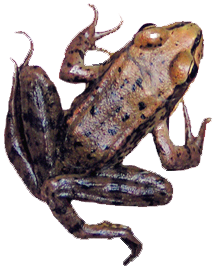January 26 - February 3, 2016
While only two of the nine nights represented here saw migrating frogs, one can’t help but be struck by how much the local temperature hovers at or around the 45 degree F threshold which largely determines -- along with moisture -- whether the frogs move or not. On January 28 at dusk it was 45, the 29th 45 at dusk and 2 hours later 43, the 30th; 43/36, 31st; 41, February 1st; 43/41, 2nd; 45/43, 3rd; 46/43. These tantalizing wet temps keep us vigilant when we’d rather be warm and dry at home, raising the question of why does temperature and moisture matter to the frogs? Northern red-leggeds lead very secretive, quiet lives in the forest, always in moist surroundings, as they must keep their skins wet to stay alive, so when they’re not around streams they find moist places under logs, duff, in burrows, under ferns, and so on, to both stay wet but also to regulate their body temperature. As the air gets colder they’ll find ways to go deeper into the ground (burrows, crevices, or simply wiggling down through leaves and duff; one female who was evading me disappeared down into the wet leaves in seconds as if she were doing the Twist). During migration they’re foregoing the protection of their reclusive forest homes. Darkness, warm and wet, is their only support as they venture out of the forest to breed (that is, till they get to the pond).
January 27 and 28 saw a pattern that recurs; a movement of frogs the first night the conditions were right (on the 27th it was 50 degrees and misty, 17 frogs caught), followed by a much larger movement the next night (on the 28th 145 frogs were caught, the temperature between 52 and 49). Interestingly, this second night began with dry pavement (which they rarely venture onto), the frogs hopping forth anyway, perhaps because they were impatient after long spells of unfavorable conditions, or, since so many headed back up to the forest over dry pavement -- 136 -- they may have some confidence they’ll be okay once back in the wet underbrush. As the night deepened light rain fell and more frogs came out, Sue’s crew staying out till 1 AM. Our totals for the season so far are 614 frogs assisted down to the wetland, 199 assisted up to the forest. We may have seen the last frog coming down, but this isn’t clear yet.
On another note, this is a photo taken toward the east north east with Mt Adams (a 12,281 foot stratovolcano) behind Cascade ridges, industry along the Willamette, and in the foreground, the Alder Creek Superfund mitigation site on the southern tip of Sauvie Island, right across from the PGE Harborton wetland.
I’m pointing this area out, the tip of the Alder Creek site, because the lagoon was carved out of the island for salmon fry to rest in on their way to the ocean. PGE Harborton is also a Superfund mitigation site (that is, interests who have incurred a “debit” to the environment -- they have polluted or otherwise damaged land -- can buy “credits” on environmentally constructive projects to offset their debit). PGE’s plans for the site appear to remove the existing wetland in favor of a stream, as they are designing with salmon and mink in mind, leaving the frogs out of the equation. (A simple solution would be to encourage beaver to dam the stream, which would benefit both the salmon and the frogs, but it’s not clear PGE would entertain this option.) We’ll keep you posted!
Some may wonder why Portland’s iconic mountain, Hood, hasn’t appeared yet. The Harborton neighborhood is in a concavity on the ridge line, so trees hide Hood except from certain angles. This picture, facing east south east, was taken yesterday morning. It’s interesting how a large mountain interacts with the sky, cloud looking like an eruption. (If anyone knows what's at play here, we'd love your input.) The towers lower left are at the river edge, leap across the water and march up over the ridge in a cut through Forest Park, which we’ll come back to later when we begin to get into new pond possibilities. The eagle we noted earlier roosts on the tallest tower in the park each night with its mate.


